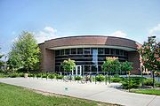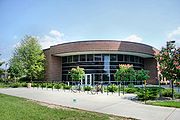
National Superconducting Cyclotron Laboratory
Encyclopedia
National Superconducting Cyclotron Laboratory (NSCL) is located on the campus of Michigan State University
and is the leading rare isotope
research facility in the United States. Established in 1963, the cyclotron
laboratory is the nation’s largest nuclear science facility on a university campus.
Funded primarily by the National Science Foundation and MSU, the NSCL operates two superconducting cyclotrons. The lab’s scientists investigate the properties of rare isotopes and nuclear reactions. In nature, these reactions would take place in star
s and exploding stellar environments such as nova
e and supernovae. The K1200 cyclotron is the highest-energy continuous beam accelerator in the world.
Currently, the laboratory's primary goal is to understand the mysteries that reside at the center of atoms, in atomic nuclei. Atomic nuclei are ten thousand times smaller than the atoms they reside in, but they contain nearly all the atom’s mass (more than 99.9 percent).
Many of the atomic nuclei found on earth are stable atomically. But there are many unstable and rare isotopes that exist in the universe, sometimes only for a fleeting moment inside "cosmic cauldrons." Scientists at the NSCL work at the forefront of rare isotope research. They make and study atomic nuclei that cannot be found on earth—where they have long decayed into the known, stable or long-lived isotopes.
Rare isotope research is essential for understanding how the elements—and ultimately the universe—were formed.
Today, approximately 10 percent of U.S. nuclear science Ph.D.s are educated at NSCL. The nuclear physics graduate program at MSU is ranked best in America by the
2010 Best Grad Schools index published by U.S. News & World Report graduate ranking.
The proposed upgrade of NSCL – the $550 million Facility for Rare Isotope Beams
(FRIB) – will boost intensities and varieties of rare isotope beams produced at MSU by replacing the K500 and K1200 cyclotrons with a powerful linear accelerator to be built beneath the ground. Such beams will allow researchers and students to continue to address a host of questions at the intellectual frontier of nuclear science: How does the behavior of novel and short-lived nuclei differ from more stable nuclei? What is the nature of nuclear processes in explosive stellar environments? What is the structure of hot nuclear matter at abnormal densities?
 Beyond basic research, FRIB may lead to cross-disciplinary benefits. Experiments there will help astronomers better interpret data from ground- and space-based observatories. Scientists at the Isotope Science Facility will contribute to research on self-organization and complexity arising from elementary interactions, a topic relevant to the life sciences and quantum computing. Additionally, the facility's capabilities may lead to advances in fields as diverse as biomedicine, materials science, national and international security, and nuclear energy.
Beyond basic research, FRIB may lead to cross-disciplinary benefits. Experiments there will help astronomers better interpret data from ground- and space-based observatories. Scientists at the Isotope Science Facility will contribute to research on self-organization and complexity arising from elementary interactions, a topic relevant to the life sciences and quantum computing. Additionally, the facility's capabilities may lead to advances in fields as diverse as biomedicine, materials science, national and international security, and nuclear energy.
(JINA) is a collaboration between Michigan State University, the University of Notre Dame, and the University of Chicago to address a broad range of experimental, theoretical, and observational questions in nuclear astrophysics. A portion of the Michigan State collaboration is housed at the National Superconducting Cyclotron Laboratory, directly involving roughly 30 nuclear physicists and astrophysicists.
Michigan State University
Michigan State University is a public research university in East Lansing, Michigan, USA. Founded in 1855, it was the pioneer land-grant institution and served as a model for future land-grant colleges in the United States under the 1862 Morrill Act.MSU pioneered the studies of packaging,...
and is the leading rare isotope
Isotope
Isotopes are variants of atoms of a particular chemical element, which have differing numbers of neutrons. Atoms of a particular element by definition must contain the same number of protons but may have a distinct number of neutrons which differs from atom to atom, without changing the designation...
research facility in the United States. Established in 1963, the cyclotron
Cyclotron
In technology, a cyclotron is a type of particle accelerator. In physics, the cyclotron frequency or gyrofrequency is the frequency of a charged particle moving perpendicularly to the direction of a uniform magnetic field, i.e. a magnetic field of constant magnitude and direction...
laboratory is the nation’s largest nuclear science facility on a university campus.
Funded primarily by the National Science Foundation and MSU, the NSCL operates two superconducting cyclotrons. The lab’s scientists investigate the properties of rare isotopes and nuclear reactions. In nature, these reactions would take place in star
Star
A star is a massive, luminous sphere of plasma held together by gravity. At the end of its lifetime, a star can also contain a proportion of degenerate matter. The nearest star to Earth is the Sun, which is the source of most of the energy on Earth...
s and exploding stellar environments such as nova
Nova
A nova is a cataclysmic nuclear explosion in a star caused by the accretion of hydrogen on to the surface of a white dwarf star, which ignites and starts nuclear fusion in a runaway manner...
e and supernovae. The K1200 cyclotron is the highest-energy continuous beam accelerator in the world.
Currently, the laboratory's primary goal is to understand the mysteries that reside at the center of atoms, in atomic nuclei. Atomic nuclei are ten thousand times smaller than the atoms they reside in, but they contain nearly all the atom’s mass (more than 99.9 percent).
Many of the atomic nuclei found on earth are stable atomically. But there are many unstable and rare isotopes that exist in the universe, sometimes only for a fleeting moment inside "cosmic cauldrons." Scientists at the NSCL work at the forefront of rare isotope research. They make and study atomic nuclei that cannot be found on earth—where they have long decayed into the known, stable or long-lived isotopes.
Rare isotope research is essential for understanding how the elements—and ultimately the universe—were formed.
Today, approximately 10 percent of U.S. nuclear science Ph.D.s are educated at NSCL. The nuclear physics graduate program at MSU is ranked best in America by the
2010 Best Grad Schools index published by U.S. News & World Report graduate ranking.
Laboratory upgrades
The upgrade plans are in close alignment with a report issued December 2006 by the National Academies, "Scientific Opportunities with a Rare-Isotope Facility in the United States," which defines a scientific agenda for a U.S.-based rare-isotope facility and addresses the need for such a facility in context of international efforts in this area. Now, NSCL is planning for a significant capability upgrade that will keep the laboratory – and nuclear science – at the cutting edge well into the 21st century.The proposed upgrade of NSCL – the $550 million Facility for Rare Isotope Beams
Facility for Rare Isotope Beams
The Facility for Rare Isotopes Beams is a planned national user facility for nuclear science research that will enable scientists to make discoveries about the properties of rare isotopes in order to better understand the physics of nuclei, nuclear astrophysics, fundamental interactions, and...
(FRIB) – will boost intensities and varieties of rare isotope beams produced at MSU by replacing the K500 and K1200 cyclotrons with a powerful linear accelerator to be built beneath the ground. Such beams will allow researchers and students to continue to address a host of questions at the intellectual frontier of nuclear science: How does the behavior of novel and short-lived nuclei differ from more stable nuclei? What is the nature of nuclear processes in explosive stellar environments? What is the structure of hot nuclear matter at abnormal densities?

Joint Institute for Nuclear Astrophysics
The Joint Institute for Nuclear AstrophysicsJoint Institute for Nuclear Astrophysics
The Joint Institute for Nuclear Astrophysics in USA is a collaboration between Michigan State University, the University of Notre Dame, and the University of Chicago to address a broad range of experimental, theoretical, and observational questions in nuclear astrophysics...
(JINA) is a collaboration between Michigan State University, the University of Notre Dame, and the University of Chicago to address a broad range of experimental, theoretical, and observational questions in nuclear astrophysics. A portion of the Michigan State collaboration is housed at the National Superconducting Cyclotron Laboratory, directly involving roughly 30 nuclear physicists and astrophysicists.
See also
- CERNCERNThe European Organization for Nuclear Research , known as CERN , is an international organization whose purpose is to operate the world's largest particle physics laboratory, which is situated in the northwest suburbs of Geneva on the Franco–Swiss border...
- Gesellschaft für SchwerionenforschungGesellschaft für SchwerionenforschungThe GSI Helmholtz Centre for Heavy Ion Research GmbH in the Wixhausen suburb of Darmstadt, Germany is a federally and state co-funded heavy ion research center. The current director of GSI is Horst Stöcker who succeeded Walter F...
- Particle physicsParticle physicsParticle physics is a branch of physics that studies the existence and interactions of particles that are the constituents of what is usually referred to as matter or radiation. In current understanding, particles are excitations of quantum fields and interact following their dynamics...
- Particle acceleratorParticle acceleratorA particle accelerator is a device that uses electromagnetic fields to propel charged particles to high speeds and to contain them in well-defined beams. An ordinary CRT television set is a simple form of accelerator. There are two basic types: electrostatic and oscillating field accelerators.In...
- CyclotronCyclotronIn technology, a cyclotron is a type of particle accelerator. In physics, the cyclotron frequency or gyrofrequency is the frequency of a charged particle moving perpendicularly to the direction of a uniform magnetic field, i.e. a magnetic field of constant magnitude and direction...
- Elementary particleElementary particleIn particle physics, an elementary particle or fundamental particle is a particle not known to have substructure; that is, it is not known to be made up of smaller particles. If an elementary particle truly has no substructure, then it is one of the basic building blocks of the universe from which...
- FRIB
External links
- Isotope Science Facility at Michigan State University
- "Scientific Opportunities with a Rare-Isotope Facility in the United States" A report by the National Academies
- "Nuclear science hits new frontiers" A commentary by NSCL Director C. Konrad Gelbke in the December 2006 CERN Courier
- “NSCL nets $100 million in NSF funds” MSU News Bulletin, Oct. 26, 2006
- The Spartan Podcast – Arden L. Bement, Jr. An audio interview with NSF Director Arden L. Bement, Jr. who visited MSU Oct. 26, 2006 to award NSCL more than $100 million to fund operations through 2011, highlighting the lab’s status as a world-leading nuclear science facility

